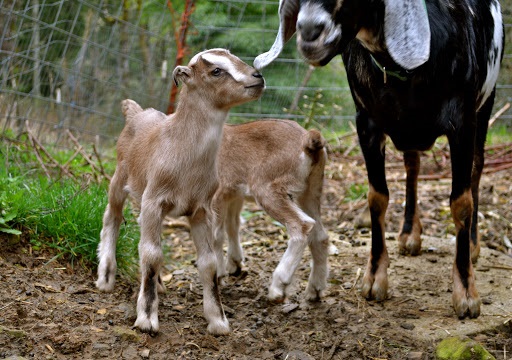

Make sure newborns are breathing. Remove any material from around the mouth and nose, clean and dry newborn with clean towel or rag. A piece of straw gently inserted up the nasal passage will stimulate breathing in a weak newborn.
Keep newborns warm and dry. Provide clean, dry, and soft bedding. When the bedding gets wet, change it or add more bedding. If it is very cold, wrap kids with a warm towel or kid sweater. If kids are in a pen, a heating lamp can be used to increase the temperature, but be sure to install it safely and correctly; do not let animals chew the cord.
Cut the umbilicus (naval cord) to 1.5 inches in length and spray it with tincture of 7 percent iodine to lower the chance of infection getting into the body.
Unless keeping kids from CAE-positive does or bottle-rearing kids, do not take them away from does. While cleaning, drying, and performing other activities with newborns, keep them close to their mothers. The development of the maternal bond between kids and their mother is extremely important.
Help weak newborns stand up and suckle. It is crucial that newborns suckle and ingest enough colostrum soon after birth. If newborns are weak and/or a dam is not interested in her newborn, be watchful as help may be required for subsequent suckling.
Bottle feed colostrum to kids if does are not producing enough or suckling is hindered. If kids are not able to stand up and suckle, the does should be milked and the kids tubed or bottle fed. Give only a few ounces at a time based on the kids’ appetite. Extra colostrum should be refrigerated and fed later by warming (100-102 degrees F or 38-39 C) it just before feeding. The bottle should be cleaned thoroughly before and after feeding. If the mother is not producing enough colostrum, colostrum should be collected from other CAE-negative does kidding around the same time and having excess production, or frozen colostrum from last year’s kidding can be thawed in a water bath and fed. Colostrum feeding must start within half an hour or so after kids are born and repeated four to five times a day. Kids will get enough immunoglobulin if 2.2 – 2.8 ounces per lb live weight (140 – 175 g colostrum per kg of live weight) is fed within 24 hours of birth. Overfeeding should be avoided because it may overwhelm the kids’ digestive system and cause diarrhea. The best thing to do is to satisfy kids’ appetite but not to force them to drink.
Certain diseases, such as Brucellosis, Johne’s disease, Caprine Arthritis Encephalitis, and Caseous Lyphadenitis can be transmitted to kids through colostrum and milk. If does are infected with any of these diseases, kids should be removed from their mothers at birth, and only colostrum from disease-negative does or heat-treated colostrum should be fed.
Keep the premises clean, well lighted, and ventilated. This will minimize the chance of infection.
Make sure premises are safe from predators.
 Contact Jaguza Support
Contact Jaguza Support